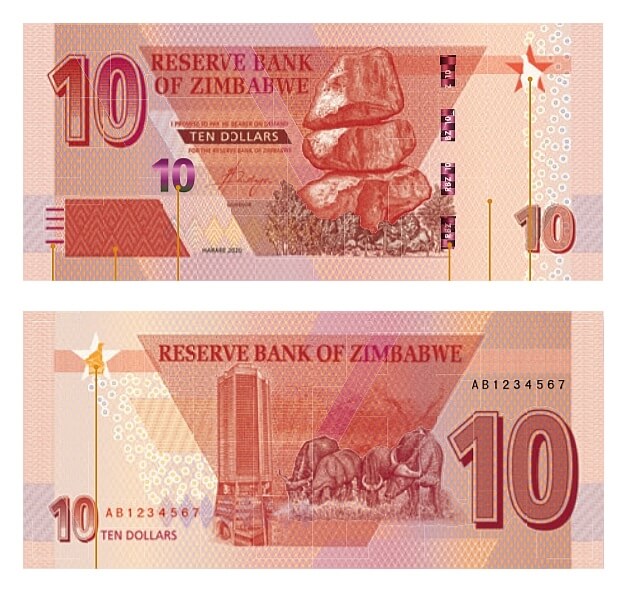The Reserve Bank of Zimbabwe have announced on the 14th May they will be releasing into circulation larger value banknotes. The release of new ZWL $10 dollar denominations will commence from the date of the announcement and the issue of the ZWL $20 denomination is scheduled to enter circulation from the first week of June 2020. The new $10 and $20 dollar denominations will circulate alongside smaller value notes of $2 and $5 dollars which were introduced late last year and which replaced so-called “bond notes” of the same design and face value at an equal exchange rate. There are also smaller coin denominations ranging from $2 to 10 cents which went into circulation in late 2018.

National Currency Abandoned Due to Extreme Inflation
After one of the world’s highest levels of inflation ever recorded, the country finally abandoned their national currency when the RBZ resorted to issuing one hundred trillion dollar banknotes in 2008. A year later, they introduced a structure of payments based on a basket of foreign currencies but predominantly based on the US Dollar. In an effort to alleviate the chronic shortage of currency in circulation and to prop up a fragile economy – especially after the deposition of the former president Robert Mugabe in 2017, the system of bond-notes and coins were gradually introduced. The Reserve Bank guaranteed their value with deposits of foreign currency and maintained a parity of the US Dollar with these notes and coins. In February 2019, and with immediate effect, the Reserve Bank declared that bond notes and all electronic payments would be merged into a new currency which they referred to as the Real Time Gross Settlement or, RTGS dollar. This unit of money with a fixed exchange rate of a 1 to 1 parity policy with the surrogate bond note currency against a US dollar exchange rate was implemented to introduce a managed floating system.
Introduction of the Zimbabwean Dollar
However, from the 24th June 2019, the Government banned the use of foreign currencies in the country which included the US Dollar and decreed the new Zimbabwean Dollar – ZWL, the sole legal tender in the form of the bond-notes and coins in circulation. Despite a limited and cautious acceptance of the currency by Zimbabweans – fearing a return to run-away inflation, The Reserve Bank continued to encourage their use by publicizing the pseudo-currency was backed up by foreign currency deposits in the Bank. In November 2019, the Reserve Bank quietly abandoned the bond-note scheme entirely when the denotation of “BOND NOTE” was removed from newer, revised banknotes.
With the introduction of a “stand-alone” currency, high levels of inflation have been experienced in the country once again. Year on year levels of price increases are now at 676% and as a result, confidence in the national currency has continued to erode. At the current RBZ exchange rate of 25 new Zimbabwean dollars – ZML to the US Dollar, the new $10 notes have a value of US$ 0.40 cents. The two banknote denominations were reportedly produced by the German security printing company, Giesecke & Devrient, based in Munich and who have had a history of doing business with Rhodesia and its successor state Zimbabwe since 1965. The banknote shipment, weighing up to 60 tonnes and valued at ZWL$ 600 million were said to have arrived in the country on the same day the Reserve Bank announced the issuance of the $10 denomination. With the Reserve Bank reporting ZWL $1.4 billion notes and coins in circulation, and with the introduction of the new supply of currency, this will take money supply in public use up to ZWL $2 billion. To further encourage the banknotes’ use and increase their circulation levels, the Reserve Bank have increased withdrawal limits from $300 per week to $1000 per week ($US 40) with effect from the 19th May 2020.
Security Features Include for Both Denominations
Tactile print: This tactile print feature identifies the denomination in a series of lines added to aid visually impaired persons.
Latent image: The numeral of the notes’ value is seen when the note is tilted under a light source.
Optical variable ink application: The note’s value is shown with a colour shifting process and changes from magenta to green on the $10 note and green to azur on the $20 note.
Holographic security thread: This vertical strip appears segmented and solid when held up to a light source and includes see-thru micro-lettering of “RBZ 10” and “RBZ 20”
Aligned print application: A perfect registry of Zimbabwe’s National Bird is printed on both front and back side, when held up to a light source, the bird is able to be recognised in perfect register.
The banknotes are expected to be in physical use from the 18th May when commercial banks will have ample supply for distribution. For additional information on the currency of Zimbabwe, please visit the website of the Reserve Bank of Zimbabwe.
The author of this article, Michael Alexander, is president of the London Banknote and Monetary Research Centre.
He recently reported on the Royal Mint manufacturing safety visors for the UK’s National Health Service.





